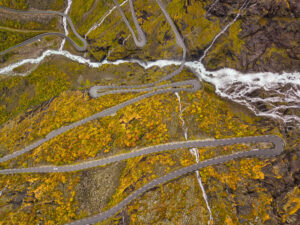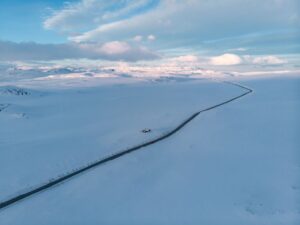Types of Campsites in Lofoten
It’s impossible to throw all campsites in Lofoten into one bag. You’d think they’d all be pretty similar—after all, you’re just paying for a flat spot to park your van or pitch your tent, and hopefully getting access to a toilet and a shower. But no. The reality? Big differences.
Some places are stuck in a 1990s time capsule—Fredvang Camping comes to mind.
Others, like the old campsite in Å or Ramberg Gjestegård, have been sold off and are slowly transforming into luxury cabin resorts.
Then you’ve got those that are genuinely trying to keep up with the modern world—like Moskenes Camping and Lofoten Beach Camp—investing in better showers, new social areas, and updated services while still feeling like a campsite.
But here’s the catch: none of them have fully embraced the 21st century. Online booking? Still a dream.
Full-Service Campsites in Lofoten
These are the places where you can pitch a tent, plug in your motorhome, use a real toilet, and maybe even take a hot shower—luxury, I know. In other words: proper full-service campsites.
That’s in contrast to motorhome parking areas (bobilplasser, bobilparkering), which may be fine for an overnight stop in a van, but:
• You can’t pitch a tent there,
• There might be no showers,
• And sometimes, not even a toilet.
So if you’re looking for something that still feels like actual camping—and not just sleeping in a parking lot with a view—this list is for you.
🏕 Lofoten Beach Camp
• Open from February to November
• Price per motorhome: 380 NOK + 80 NOK for electricity
• Price per tent (without a car): 280 NOK
If we had to pick just one campsite to recommend, Lofoten Beach Camp would probably be it. It’s right next to Skagsanden Beach, which is not only one of the best spots to watch the midnight sun in summer and northern lights in winter — but it also has real surf.
The facilities are top-notch (think brand-new showers and toilets, strong WiFi, and even a sauna), and the beach bar is a proper hangout serving everything from breakfast to burgers to pastries.
The place is huge, with plenty of space for tents and motorhomes, but it’s not inflatable — so yes, it does get full in the summer. If you want a spot, come early.
🏕 Moskenes Camping
• Open from May to September
• Price per motorhome: approx. 300–350 NOK + 50–80 NOK for electricity
• Price per tent: approx. 250–300 NOK
Moskenes Camping is, hands down, the best campsite to stay if you’re arriving or leaving with the Bodø – Moskenes ferry, but the location isn’t the only reason it’s so good.
The campsite is spacious and nicely tucked away with a peaceful feel, despite being just a short walk from the Moskenes ferry terminal. There’s a little pub on-site that serves simple meals, snacks, and ice cream, which is very welcome after a long travel day – especially if you do not have a car, since there is no grocery store in Moskenes.
The facilities are clean and well maintained. There are two service buildings with 18 toilets and 12 showers in peak season. There’s also a guest kitchen and a washing machine.
It’s not as flashy or social as Lofoten Beach Camp, but for some quiet nights surrounded by mountains, it’s one of the best campsites in Lofoten.
🚐 Ramberg Resort (formerly Ramberg Gjestegård)
• Open the whole year
• Price per motorhome: 595 NOK (electricity included)
• No tent camping available
Ramberg Gjestegård used to be a legendary camping in Lofoten — right on the beach, lots of space, decent facilities, and one of the best views you could ask for. It had a proper old-school camping vibe: restaurant in the main house, 10 beach cabins, and room for both tents and campervans just a short stroll from the sand.
Then, in 2022, the place got new owners, a new name (Ramberg Resort), and a bit of a makeover. Out went the tents, and in came the upgraded beach cabins, now branded as bungalows, and new modern apartments aimed at a more upscale crowd.
They’ve kept space for about 25 motorhomes, so if you’re rolling in with a campervan or motorhome, you can still stay here. But if you’re hoping to pitch a tent, this one’s off the list.
🏕 Fredvang Camping
• Open from May to September
• Price per motorhome: approx. 360 NOK (extra payment for showers and other services)
• Price per tent: approx. 220 NOK
Fredvang Camping has such an incredible location that if it ever went up for sale and we had the money — we’d probably buy it. Tucked away on a quiet stretch of coast just a stone’s throw from some of the most underrated beaches in Lofoten, this place is pure peace.
The best part? The beaches are practically private, as only the campsite guests seem to get to them.
If you’re planning to hike Ryten or Kvalvika, this is the perfect base. You’re right there, and you get to avoid the traffic and packed parking areas around the more popular trailheads.
Now, let’s talk facilities. Don’t expect much. Showers are coin-operated and run on a timer, and the vibe is definitely more “back to basics.”
One thing worth mentioning: we used to run a nearby accommodation in 2021 and had a few last-minute guests check in after leaving (or being kicked out of) Fredvang Camping.
While we haven’t had any direct issues ourselves, reviews seem to reflect that the management style hasn’t changed much over the years. That said, there are also plenty of happy campers who loved their stay at Fredvang Camping, so see it for yourselves.
Dedicated Motorhome/Campervan Parking Areas (Bobilplasser)
These are not campsites, and they’re not pretending to be. Dedicated motorhome parking areas—bobilplasser—are often just gravel lots or roadside pull-outs where motorhomes can legally park overnight.
Facilities range from basic to non-existent: some might have a toilet, a water tap, or a waste station, but others offer no showers, no kitchen, and definitely no tent pitches. They’re often cheaper than full-service campsites and can work fine for a night or two if you’re fully self-contained.
🚐 Olenilsøy Sea Side Caravan Parking (Reine)
• Open during the summer
• Price per motorhome: approx. 300 NOK
This is a newly built motorhome parking area on the island of Olenilsøy, just a stone’s throw from Anita’s Seafood (yes, that Anita’s). It’s run by a local couple, Carl-Fredrik and Marta, who also own the nearby Rostad Retro Rorbuer and Sakrisøy Gjestegård—perfect if you’re suddenly in the mood for something (a lot) fancier.
The location? Absolutely stunning. You’ll be hard-pressed to find a better view in Lofoten, especially with the iconic Olstind mountain backdrop. The facilities are still fairly basic, but Carl-Fredrik and Marta are working on it.
As of now, they offer:
🚐 Space for around 20 motorhomes
✅ Drinking water refill
✅ Grey and black water disposal
🚿Showers and toilets are in the works
🅿️ Ytre Havn Parking (Reine Outer Harbour)
Ytre Havn is a large parking area located in the outer harbour of Reine, right next to the pier where the Reinefjorden ferry docks. It’s a convenient spot with plenty of space, but the setup can be a bit confusing, especially for first-time visitors—so here’s the breakdown.
Municipality Parking (Moskenes kommune)
The first section, just past the entrance and marked by electric car chargers and a bom (that’s a barrier gate, for non-Norwegians), belongs to Moskenes kommune.
This area is primarily meant for Reine visitors and Reinebringen hikers, not overnight stays, although it’s not strictly enforced.
• Payment via EasyPark app or parking machine
• 43.75 NOK/hour for any kind of vehicle
• No overnight facilities (paid toilet, no water, no shower, and no electricity)
Reine Harbour Parking (Fellesdrift Reine Ytre Havn)
If you drive a little further into the harbour, you’ll reach a separate section—Fellesdrift Reine Ytre Havn runs this one. This is the one you’re probably looking for if you’re hoping to stay overnight in your motorhome.
• 250 NOK/day
• No facilities — paid toilet nearby, no water or electricity, so you need to be fully self-contained
• Payment options — VIPPS (for Norwegian users), SumUp (works internationally), Cash (exact amount in an envelope), Credit card (send a message to the owner, they’ll stop by with a payment terminal)
Reine Ytre Havn is not a campsite, but it’s quiet, flat, and in a fantastic location, especially if you plan to take the ferry or just soak up the view. Just don’t expect any services—it’s a proper no-frills parking area.





